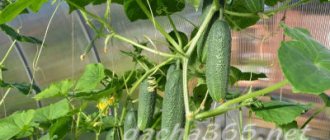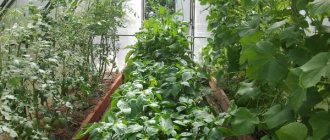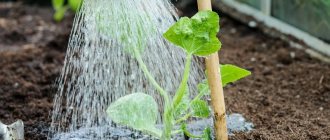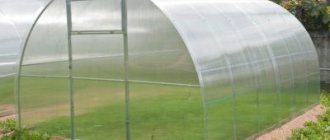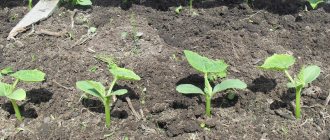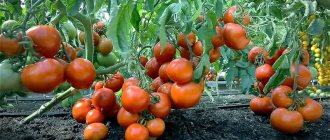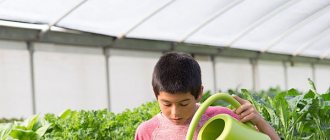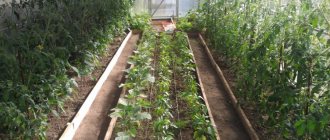The beds in a greenhouse 3 by 6 meters have their own design nuances. Today we will look at all the features in more detail, we will pay attention to the arrangement of beds in two and three rows, their location in the greenhouse. Then, taking into account all the advice, gardeners will be able to place the plantings in the most successful way. It will be comfortable to work in the greenhouse.
Beds in a greenhouse 3 by 6
Arrangement of beds in greenhouses 3 by 6
Typically, compact greenhouses 3x6 m are widely in demand in suburban and summer cottage areas. Here are the key features of such greenhouses.
- The greenhouse must be placed in an open place. It is important to organize a convenient approach to it.
- The beds usually run along the long sides, along the walls.
- For better and longer-lasting lighting, the long side should be facing west.
- It is important to create conditions for comfortable care of the beds. The height of the ridges relative to the path is usually a maximum of 40 cm.
- It is advisable to leave paths at least 45 cm wide. Only in such conditions is full-fledged effective work possible.
- It is better to make beds 60 or 90 cm long. Wider beds are used with paths on both sides, and when approaching from one side, beds 60 cm wide are suitable.
Optimal width of beds in a greenhouse
It is important! It is necessary to take care of the proper width of the paths. If they are too narrow, it is inconvenient to walk on them, there is no place to mark the necessary equipment, inventory, watering hoses, and the integrity of the beds will be constantly compromised. It is much more convenient to work with wide paths.
Greenhouse made of polycarbonate 3 by 6
We arrange the beds rationally
There are several simple secrets to the proper arrangement of beds.
- For example, it is advisable to plant tall varieties in two rows. They are formed into several stems, and a gap of 80 cm is left between the rows.
- A good solution is to combine different varieties. Tall crops are planted in the center of the greenhouse, and low-growing crops are planted on the sides. It’s great when vegetables ripen at different times. Then you can collect a fresh harvest for a longer period.
- If the greenhouse is not made of polycarbonate, but double bubble, with reinforced film, you can also achieve a high yield. To do this, you will need low-growing varieties, if we talk about, say, tomatoes. The rows are formed into two and three stems, without stepsons. It is most effective to grow early ripening varieties under such conditions. A good solution is to plant the bushes in a checkerboard pattern. In this case, it is necessary to leave free space between the rows (approximately 50 cm).
Scheme of tomato formation in a greenhouse.
- When there are only two beds in the greenhouse, the two-row staggered method and the single-row method work well. All this will depend on the specific type of plant.
- If there are three beds in the greenhouse, but the dimensions are modest 3 by 6, you need to plant the crops in one row on the sides, and make two rows in the central bed. This is the optimal solution, providing maximum compactness and comfort. At the same time, the plants must be comfortable in the greenhouse, they must receive the necessary space and nutrition.
Option with three beds (in the center)
It is important! Remember the key principles for choosing the optimal planting pattern. It is necessary to rationally use the entire area of the greenhouse, and be sure to provide free access to every bush, plant, and branch. In addition, the conditions for the plants themselves must be the best - so that there is enough light and nutrition.
Stationary beds at waist level
How to achieve a good harvest when growing together
Before you start planting, the beds for cucumbers and tomatoes need to be carefully prepared.
Every gardener knows that to ensure high harvest rates, one of the decisive factors is soil preparation. This process must begin a month before planting, and in some cases, even in the winter. The earth is fluffed up (to saturate it with oxygen) and enriched with organic fertilizers - humus.
- As compost decomposes, it warms the earth, which is why such beds are called “warm”. They are ideal for planting cucumbers.
- To protect future crops from all kinds of diseases, the soil is disinfected with a weak solution of potassium permanganate.
- The holes are dug in advance, filled with minerals and fertilizers, and allowed to brew so that excess moisture is absorbed.
- Only after this, plants are planted in them.
Attention! Seedlings should not be placed in soil that is too wet, as they may grow deeper and rot!
We plant tomatoes in a greenhouse measuring 3 by 6 meters
In the summary table we will look at the key features of planting crops. As an example, we take planting tomato bushes in a polycarbonate greenhouse. We will pay attention to the features, key characteristics of planting, as well as the method of planting. We will also indicate approximate calculations for two and three beds in a greenhouse 3 by 6 meters.
Growing tomatoes in a 3x6 meter greenhouse
Table. Features of planting tomatoes in a polycarbonate greenhouse.
| Index | Two beds | Three beds |
| Peculiarities | It is better to place the beds along the long sides. Then the width of the bed will be approximately 100 cm, and the rest of the area will be needed for the path. | A more convenient option with efficient use of space. You can make the paths a little wider by narrowing the beds. |
| Disembarkation method | It is optimal to use the two-line method and square-cluster planting. Sometimes, for greater comfort, bushes are placed in a checkerboard pattern. | A checkerboard arrangement of bushes is optimal. The square-nested method is used a little less frequently. |
| Calculation | In total, you can plant 60 bushes if you leave a gap between the rows of 60 cm, and the distance between the bushes is only 40 cm. Then 15 bushes can occupy 1 row. | It is recommended to seal the gap to 30 cm. Then you can plant 20 bushes in one row at once. |
Tape two-line scheme for planting tomatoes
Now let's look at the important points in a little more detail.
Planting in a greenhouse in two beds
Many gardeners and experts note that it is more convenient and easier to place beds along the entire length of the greenhouse, along the walls. For standard above-ground beds, the traditional height is 30-40 cm. At the same time, it is important to take care of the required width of the path, otherwise it will be inconvenient to use and place tools, walk with a wheelbarrow, and water the plants.
Two beds in a greenhouse
For high quality and speed of work, it is important to have adequate free space. Most often, bushes are planted in nests in the form of squares or rectangles, as well as in two lines.
Three beds in a greenhouse
This method is more popular because it allows for the most competent and efficient use of the entire area. At the same time, you can achieve a sufficient width of the paths, making the beds along the edges more compact.
Three beds in a greenhouse
For those who are planning to plant tomato bushes, there is special advice: it is better to plant determinate varieties of tomatoes on the outer rows, since the greenhouse has a low height near the walls compared to the central part. It is advisable to select in advance varieties with medium height and early ripening.
Let's look at planting tomatoes in a 3 by 6 greenhouse with three beds in more detail. It is better to form the outer rows into two stems, while increasing the gap between them. On average, it should be approximately 40 cm, since bushes with large volumes need increased nutrition. It is easy to calculate the number of bushes in a row: simply divide 600 by 40. As a result, it turns out that you can plant 15 tomato bushes in a row. In total, in one greenhouse with such parameters it is quite possible to freely place as many as 90 bushes with tomatoes, while their harvest time will be extended.
Layout of three beds
You can also select beds in a special way based on ripeness. It is advisable to grow mid-season, mid-early varieties in the center. But early ripening early tomatoes are more suitable for side beds.
The optimal solution is to ripen the tomatoes one at a time. It is very important to choose the right varieties in accordance with your budget, taste preferences, and soil characteristics. Then all the tomatoes will ripen one by one, and there will always be fresh, delicious tomatoes on the table.
How to grow cucumbers with tomatoes. Varieties most suitable for neighborhood
It is possible to achieve the highest possible yields while simultaneously growing cucumbers and tomatoes if you select plant varieties that are compatible with each other.
For such experiments, it is necessary to select tomatoes intended for growing in conditions of high humidity. Also, these varieties should have immunity to late blight. These include the following types of tomatoes:
- Dubrava, oak tree.
- Dwarf.
- Tsar Peter.
- Lark.
- La La Fa.
Cucumbers, in turn, should easily tolerate dry climates. Best suited for growing together:
- Baby crane.
- Masha.
- Benefit.
- Pasadena.
- Thumb Boy.
It is very important to take a responsible approach to the selection of varieties that you plan to combine. Otherwise, you may completely lose your harvest.
Important! Diseases that cause plant rotting are easily transmitted from one species to another. If you miss the onset of the disease and do not stop it in time, you can suffer colossal losses!
Basic principles for creating beds in a greenhouse
Now it’s time to consider the formation of beds in greenhouses with dimensions of 3 by 6 meters.
We focus on the cardinal directions
First of all, you need to remember the cardinal directions when planting beds with different crops. You can use boxes, racks, or make beds directly on the ground. In any case, the location of plants relative to the cardinal points will be of great importance. Plants should receive maximum heat and light, solar energy.
Optimal location of the greenhouse on the cardinal points
For accurate orientation, you will need a compass. It is best to place the beds in a direction from north to south. This is when the plants will be able to receive more sunlight throughout the day.
It is important to remember: regardless of the culture, type, dependence on heat and light, each plant must be placed in the beds, taking into account its maximum possible growth before harvesting. Under no circumstances should low-growing plants be in the shade of tall ones.
Low-growing plants in the greenhouse should not be in the shadow of tall ones
Plant height arrangement
Experts note: it is tall plants that need a special approach. Large growth and the presence of foliage determine significant shading of the bed. As a result, other plants may suffer from lack of heat and light. The optimal solution is to place tall plants along the “east-west” line. Then the lower tiers of leaves will be perfectly illuminated by the morning sunlight.
Tomatoes are planted in a greenhouse according to this scheme. On the north side there is a row of indeterminate tomatoes with a height of up to 2.5 meters.
Sometimes it happens that greenhouses have to be installed in uneven terrain. In this case, it is advisable to choose a slope with a southern exposure. Such a site should have a slope oriented to the south. Shelves and beds are placed across the slope. This is an ideal option because the maximum number of plants will be exposed to direct sunlight, since they will fall on the greenhouse at an angle.
It is important! You may encounter various interferences and problems when orienting yourself in accordance with the cardinal directions. If you cannot install the greenhouse properly, you have to choose the best possible option.
There are also pitfalls. For example, if the slope is southern, but there is shadow from the tree crowns, the best option would be to locate the greenhouse on a northern slope, but free from plantings.
We take into account the design features of the greenhouse
Design features also influence the order of planting in their own way. Here's what you need to take into account.
- For growing short trees and tall crops, a gable-type greenhouse is optimal. You can use the space as rationally as possible if you make a bed directly in the center, under the ridge, that is, in the place where the ceiling is highest. Then the tallest crops can be planted there.
Gable greenhouse 3 by 6 meters
Advice! Experts and experienced gardeners note that you cannot save on passes. The paths must be comfortable. The optimal minimum is 40 cm. Have you decided to use a wheelbarrow? Then it is better to leave an 80 cm passage in the center, and plant the plants on the sides in two beds.
Readiness of seedlings
Two or three true leaves indicate the readiness of cucumber seedlings for planting. This is approximately three weeks of age. Tomatoes should sit for at least one and a half months before they are ready to plant. The finished tomato seedlings must have a strong root, at least thirty centimeters in height, a developed root system, at least 6-7 true leaves and an emerging flower bud or, depending on the variety, a brush. A pepper seedling ready for planting should be at least two to two and a half months old. Its preferred “height” is 25 centimeters, 6-8 true leaves and the presence of a flower ovary.
- – this is not critical. It’s worse if the plant gets into unheated soil and stops growing.
Smart use of verticals
It is not at all necessary to place the beds exclusively in one plane. You have an excellent opportunity to organize a shelving structure in the greenhouse. It is the vertical layout of the beds that allows you to very efficiently use all the free space. However, there are also difficulties here. It is extremely important to distribute all plants and containers with soil in such a way that the lower tiers are not in the shadow of the upper ones.
Greenhouse shelving
Here are three simple rules for shelving.
- Directly under the shelving, you can make a warehouse-type niche to store the necessary equipment.
- The lower and middle tiers are ideal for adult plants. You can also place containers with fertile soil in which young bushes are planted. For example, this is a good solution when growing strawberries using the Dutch method.
- Containers with seedlings most need warmth and light. That is why they should be placed on the uppermost tiers when placing beds in racks. In accordance with growth and development, they can be gradually moved lower.
Shelving and pots for plants in the arrangement of a greenhouse
It is important! Hold yourself to a certain standard. The depth of the rack should be no more than 50 cm. Then the shelves will not shade the plants.
The vertical can also be used for terraced arrangement of beds. This is also a good option for those who want to gradually switch to shelving. In the greenhouse, on one side the beds are left traditional. The southeast or south side is more suitable for this. But a terrace can be made on the opposite side of the greenhouse.
An example of creating terraced beds
It is worth noting that such experimental designs are appropriate in cases where the combined cultivation of different crops is carried out within the same greenhouse. If one crop is grown, it is necessary to create uniform conditions throughout the entire area.
Planning the greenhouse area according to Mittleider
Traditionally, the layout of beds in two and three rows is used. Both options are quite feasible in greenhouses with dimensions of 3 by 6 meters. We provided approximate calculations above. However, there is another known method, an innovative one - the method of Jacob Mittleider.
Scheme of a Mittleider greenhouse with three beds
When a greenhouse is planned according to Mitlider, crops are planted in beds 45 cm wide. This resembles the traditional option. However, it is recommended to make the widest possible paths between the beds. For example, a good passage width is 90 cm. This technique will ensure good air flow and sufficient illumination.
Layout of beds according to Mittleider.
The technique involves creating comfortable conditions for the gardener. It is recommended to plant plants in two narrow rows, leaving free soil between them. In this case, there will be a good air exchange, and the person will not have to reach far to the bushes to work.
Scheme for growing vegetables in box-beds according to Mittleider
The most original method is to place the beds on racks that are arranged in a spiral. Can be made from pipes that are used for communications and water supply. This method is ideal for growing low-growing crops, such as greens and strawberries.
Making the best beds in a 3 by 6 greenhouse
It's time to look at the step-by-step instructions for arranging beds in a greenhouse. It is important to ensure maximum efficiency and create the best conditions for plants.
You will need fertile soil. The soil is prepared specially or purchased ready-made. In addition, you need to stock up on boards, sawdust or straw. You will also need manure as the main fertilizing layer. We act according to the algorithm.
Step 1. First, a trench is dug at the site of the bed.
First you need to dig a trench
Step 2. Then you need to install a fence - formwork made of wooden boards.
Options for fastening boards in wooden fences for beds and flower beds
An example of a wooden fence for garden beds
Step 3. Then pour out a layer of straw or sawdust. Its thickness should be 10-15 cm.
Step 4. Then comes the turn of manure. You need to take manure, which is already beginning to rot. The layer is made compacted. Height – 20 cm.
Use manure that has already begun to rot
Step 5. The created pillow is poured with boiling water to soak the manure and the bottom layer. After this, the beds should be left alone for two days.
The beds are filled with manure, now they need to be watered with boiling water
Step 6. Next, you can add a layer of fertile soil and peat. It should have a height of 30 cm.
The beds are covered with a 30-centimeter layer of soil
Peat prices
peat
You can make multi-layer fertilizer using chicken manure and a decomposition stimulator. When decay is intense, maximum thermal energy is released. This is precisely what is necessary for better growth of planted crops. You can leave organic fertilizer under the black film for a week so that it warms up well, and then pour out the soil and plant the plants.
Organic fertilizer can be covered with black film for a week (pictured is a mini-greenhouse)
To protect seedlings from rodents, you can line the bottom layer with a special mesh. Also, sometimes instead of sawdust, rotten boards, bark and stumps are placed down. Manure can be replaced with grass humus. Everything must be compacted well and poured with boiling water; be sure to let these layers “simmer” before filling in the soil.
How to make beds in a polycarbonate greenhouse
To find out how to properly make beds in a polycarbonate greenhouse, as well as which beds are generally suitable, read this article! We also recommend reading about the watering hose.
Even marshy, rocky or sandy soil can provide good conditions for growing various crops. Simply install the boxes and fill them with fertile soil. The boxes are warmer and protect against pests. The height of the box is approximately 40 cm.
Example of an alternative: growing tomatoes in buckets
Plants in buckets are easy to care for
Preparing seedlings
The ability to plant seeds correctly is the first step to a harvest. Before planting, plant seeds should be wrapped in a gauze “blanket” and well moistened with warm water. Before sowing, the seeds can be treated with a weak (the color of “liquid” tea) solution of potassium permanganate. This should strengthen the immunity of cucumbers, tomatoes and peppers. . Prepared plant seeds are laid out on slightly pressed and moistened soil with a spray bottle. The seeds are sprinkled with soil on top to a height of 0.5-1 cm. The container with the planted seeds should be marked, indicating the plant culture (tomatoes, peppers, cucumbers) and the name of the variety. Moisten the soil again with a spray bottle and cover with film to prevent the soil from drying out. Prepared seedlings can be taken out to an insulated balcony or placed on a windowsill.
Picking and thinning of seedlings is done in order to separate weak and diseased plants from healthy plants. Fill a box or other container for seedlings 2/3 with soil. You can apply fertilizers for seedlings, which you can choose in specialized stores. Prepare a hole for each seedling. When separating a seedling, remember that the integrity of the root system must be maintained. You should plant it by carefully straightening the roots. After planting the seedlings in the box, add soil and moisten it generously.

